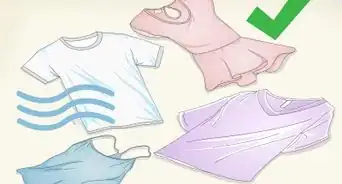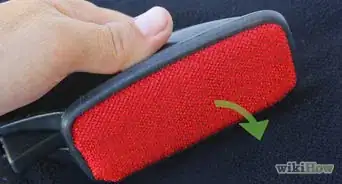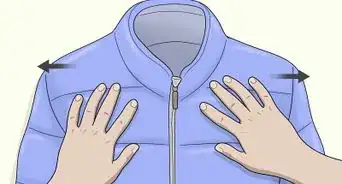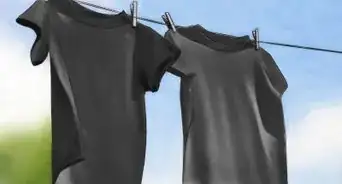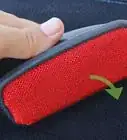This article was co-authored by Ayad Mirjan. Ayad Mirjan is a Dry Cleaner and Laundry Specialist and the Founder of OrangeBag®, a toxin-free, sustainable, Los Angeles-based laundry and dry cleaning delivery service. Ayad has over four years of experience in the industry and he specializes in providing easy laundry and dry-cleaning solutions to professionals, families, and businesses. Ayad received his Bachelor's degree from The University of California, San Diego, and an MBA from Henley Business School. He is also a board member of the Entrepreneur's Organization Accelerator (EOA).
wikiHow marks an article as reader-approved once it receives enough positive feedback. In this case, 100% of readers who voted found the article helpful, earning it our reader-approved status.
This article has been viewed 416,213 times.
Washing clothes by hand typically uses less energy and water than washing machines, and may be less likely to cause damage. It's also a handy skill to know if you're traveling without access to a wash machine, or if your power goes out.
Steps
Washing Normal Clothing by Hand
-
1Separate the white and colored clothing (recommended). Washing clothes by hand usually involves lower temperatures and less agitation than most washing machines, so there is less risk of color bleeding. It can still occur, however, so separating white and light pastel clothing from darker colored clothing is recommended.
- Separate out wool, cashmere, silk, lace, and any other delicate clothing from your other laundry. Wash these items using the instructions for delicate clothing, in a separate load.
-
2Lay the clothes in a clean container. If you don't have a large washing tub or bucket, you can thoroughly clean a sink or bathtub and place the clothes in there, spreading them out evenly. The less full the container is, the easier it will be to wash. If you have too many clothes to wash at once, consider keeping a second clean bucket nearby to store clean, wet clothes while you finish washing the rest of the load.
- If you are only washing a couple small articles of clothing, you may only need a large bowl.
Advertisement -
3Treat serious stains with a pre-wash stain remover or soap. If your clothing has a stain that has dyed the fabric, such as a stain from mustard or ink, rub a little stain remover cleaning product over the affected area, or use soap if you do not have any stain remover. Let the clothing sit for at least five minutes before continuing.
-
4Fill the bucket with lukewarm water. Fill until the water level is about 1–2 inches (2.5–5 cm) above the level of the clothing.[1] Unless the clothing is both sturdy and heavily soiled, do not use hot water. Lukewarm or even room temperature water will work fine for most laundry loads, and reduces the chance of damaging or color bleeding.
- If you are not certain whether an article of clothing can be washed in warm water, play it safe and use cool water instead.
-
5Add laundry detergent. If you are using a bucket or sink, you likely only need one to two tsp (5–10mL) mild detergent or washing powder. If you have enough clothing to require a bathtub, use 4 tbsp (60 mL) instead, or follow the instruction on the package.[2]
- If your detergent is not labeled "mild," or if you have sensitive skin, wear rubber gloves to prevent rashes or itching.
-
6Let the clothing soak. The detergent will take time to work, so leave the tub of water alone for at least twenty minutes. If your clothing has a significant amount of dirt or stains, you may wish to leave it for up to an hour.
-
7Swish the clothing around in the water. Using either your hands or a simple agitator tool, move the clothing gently around in the water. Press the clothing against the bottom or sides until suds emerge, but try not to scrub or twist it, as this could stretch the clothes.[3] Do this for about two minutes, or until the clothing is clean.
-
8Rinse repeatedly in new, cool water. Empty the water from the container, and fill with cool water.[4] Continue moving the clothing around in the same way, pressing to remove the soap suds. After a couple of minutes, drain again and repeat an additional one or two times. Once no soap suds are visible when the clothing is moved or pressed, the clothes are ready to dry.
- If you are filling the container from a faucet, you may start rinsing before it's full by holding clothing in the running water.
-
9Wring and dry the clothing. Twist each article of clothing to remove most of the water, or send it through a hand-cranked wringer if you have one. If you are not using a dryer, hang the clothing on a clothes horse, clothesline, or the backs of chairs and banisters. Make sure the clothing is spread out evenly, and that articles of clothing don't overlap with other. If a wet area is hidden by other clothing or a bunched up area of fabric, it will take much longer to dry.
- Keep in mind that wet clothing will drip, and may leave a stain on hard wood or upholstery if draped directly on it.
- On a sunny day, your clothes should dry within a few hours.
- If you do not have sun, dry in a warm, ventilated room.
-
10Consider buying or making an agitator. It's not difficult to wash a load of laundry without any tools, but it can be tedious. If you plan to wash all your laundry by hand, especially towels, jeans, and other heavy items of clothing, you may wish to use a handheld agitator, which is simply a plastic tool useful for pressing and moving the clothes. If you cannot find one in a store, look online or make your own by cutting a few holes in the rubber of a brand-new plunger.[5]
- Note: You may use these instructions whether or not you have an agitator.
Washing and Drying Wool or Delicate Clothing
-
1Fill a container with cool water. If you are only washing a few pieces of clothing, you only need enough water to submerge them one at a time. You may use a washing tub or bucket, or scrub a sink clean and put in a stopper. Some delicate clothing may be damaged by warm water, so only use cool unless the clothing is heavily stained.
- Alternatively, if you only have a couple pieces of lingerie or other small items, bring them into a cool or lukewarm shower.[6]
-
2If your water is hard, add a little borax or baking soda. Hard water leaves a white, mineral residue on pipes, sinks, and dishes after heavy use. If this happens with your water, counteract this effect on delicate clothing by stirring in a spoonful of powdered borax.[7] Baking soda is less effective, but has a similar ability to soften water.
-
3Add a tiny amount of mild soap. Mix in a few drops of extra mild detergent or soap, stirring until a few suds are visible. If you are not sure whether your detergent is mild, baby shampoo is a good option, and normal shampoo is suitable.[8]
-
4Measure wool or cashmere clothing before washing. Material that can absorb a great deal of water, most notably wool and cashmere, will typically change size and shape in the wash. This can be counteracted by drying it in the correct position, but in order to do this you will need to know the correct size of the clothing.
- Measure a sweater's width at the neck, shoulders, and base. Measure the length of the sleeves.
- Make a rough sketch labeled with your measurements for sweaters or other articles of clothing that require several measurements.
-
5Gently press each article of clothing under the water. Some materials, such as silk or elastic, will last longer if you minimize the amount of time it spends soaking, so try not to spend more than a few minutes on each item unless there is still visible dirt on the clothing.[9] Swish gently back and forth, pressing or squeezing lightly.
-
6Rinse the clothing. Squeeze out the soapy water by balling up the article of clothing and compressing gently.[10] Dip it in clean water without soap, then squeeze it again. Repeat until no suds are visible when you squeeze.
-
7Learn how to dry wool or cashmere clothing. Lay out a large, white towel and arrange your article of clothing on top of it. Refer to your measurements from before washing and gently tug the clothing into its original shape. Roll up the towel around the item in this shape, then press the towel to remove excess moisture. Place the towel on a water-safe surface away from heat, unroll it, and leave the clothing to dry on top of the towel.
- A colored towel may stain wet wool or cashmere.
- After a few hours, if the clothing is not yet dry, flip it over or transfer to a dry towel.
-
8Dry other delicate clothing on a clothesline or clothes horse. You may use the low or delicate setting on a dryer, but the best way to maintain the longevity of your delicate clothing is to air dry it. Place it on a clothesline or clothes horse in a sunny area, or at least a slightly warm and ventilated area. Avoid applying direct heat, such as with a hair dryer or heater surface, as this may warp the clothing.
Community Q&A
-
QuestionCan sheets and towels be hand washed?
 Community AnswerYes. They hand washed everything in the old days.
Community AnswerYes. They hand washed everything in the old days. -
QuestionIs washing by hand effective compared to using a washing machine?
 Community AnswerBoth are effective. Some people prefer hand washing their clothes because it saves money or they don’t have a washing machine available.
Community AnswerBoth are effective. Some people prefer hand washing their clothes because it saves money or they don’t have a washing machine available. -
QuestionHow do I clean if I don't have any supplies?
 Community AnswerUse sunlight. It won't clean the stains, but bacteria and most of the odor will dissipate in the presence of sunlight.
Community AnswerUse sunlight. It won't clean the stains, but bacteria and most of the odor will dissipate in the presence of sunlight.
Warnings
- Do not use a brush or agitator for delicate clothing.⧼thumbs_response⧽
- Do not dry clothing directly on a heater or other heat source, as this could start a fire.⧼thumbs_response⧽
- Bleach may irritate your skin, and is not recommended for hand washing. If laundry is heavily soiled and cannot be cleaned by ordinary detergent, add 1/2 the recommended amount of bleach and wear rubber gloves while washing. Use color safe bleach for colored clothes to prevent discoloration.⧼thumbs_response⧽
Things You'll Need
- Washing powder or mild laundry detergent
- Soap or stain remover (optional)
- Brush
- Bucket, sink, or bathtub
& for delicates:
- Large, white towel
- Extra-mild detergent, baby shampoo, or
- Agitator
References
- ↑ Ayad Mirjan. Dry Cleaner & Laundry Specialist. Expert Interview. 11 August 2021.
- ↑ http://cleaningouttheclutter.com/2013/05/washing-clothes-by-hand-and-tips-for-line-drying/
- ↑ http://www.bhg.com/homekeeping/laundry-linens/clothes/how-to-wash-clothes-by-hand/
- ↑ Ayad Mirjan. Dry Cleaner & Laundry Specialist. Expert Interview. 11 August 2021.
- ↑ http://cleaningouttheclutter.com/2013/05/washing-clothes-by-hand-and-tips-for-line-drying/
- ↑ http://www.realsimple.com/home-organizing/cleaning/laundry/how-to-clean-undergarments-delicates-10000001721821/index.html
- ↑ http://texeresilk.com/article/silk_care_cleaning_washing
- ↑ http://www.realsimple.com/home-organizing/cleaning/laundry/how-to-clean-undergarments-delicates-10000001721821/index.html
- ↑ http://texeresilk.com/article/silk_care_cleaning_washing
About This Article
To wash clothes without a washing machine, first put them in a bucket, or in your sink or bathtub. Then, fill your container with lukewarm water until your clothes are completely submerged. Next, add 1-2 teaspoons of laundry detergent to your bucket or sink, or 4 tablespoons to your bathtub. Let the clothes soak for 20 minutes before you swish them around with your hands. Finally, empty the water, add new, cool water, and swish the clothes around again to rinse out all the soap. Wring the clothes out to dry. To learn how to hand wash wool or delicate clothes, keep reading!














